
Rescuers search for victims at a village heavily affected by a landslide in Cigudeg, West Java, Indonesia, Friday, Jan. 3, 2020. Monsoon rains and rising rivers submerged hundreds of neighborhoods in greater Jakarta and caused landslides in the neighboring districts, which buried a number of people. (AP Photo/Kozer)
Tens of thousands of Indonesians were crammed in emergency shelters Saturday waiting for floodwaters to recede in and around the capital, Jakarta, as the death toll from massive New Year's flooding reached 47, officials said.
Monsoon rains and rising rivers submerged a dozen districts in greater Jakarta and caused landslides in the Bogor and Depok districts on the city's outskirts as well as in neighboring Lebak, which buried a dozen people.
National Disaster Mitigation Agency spokesman Agus Wibowo said the fatalities also included those who had drowned or been electrocuted since rivers broke their banks early Wednesday after extreme torrential rains throughout New Year's Eve. Three elderly people died of hypothermia.
It was the worst flooding since 2007, when 80 people were killed over 10 days.
"The waters came very fast, suddenly everything in my house was swept away," said Dian Puspitasari, a mother of 2, who looked overwhelmed trying to sweep piles of mud out of her home. "To clean up this thick mud is another disaster for us."
Four days after the region of 30 million people was struck by flashfloods, waters have receded in many middle-class districts, but conditions remained grim in narrow riverside alleys where the city's poor live.
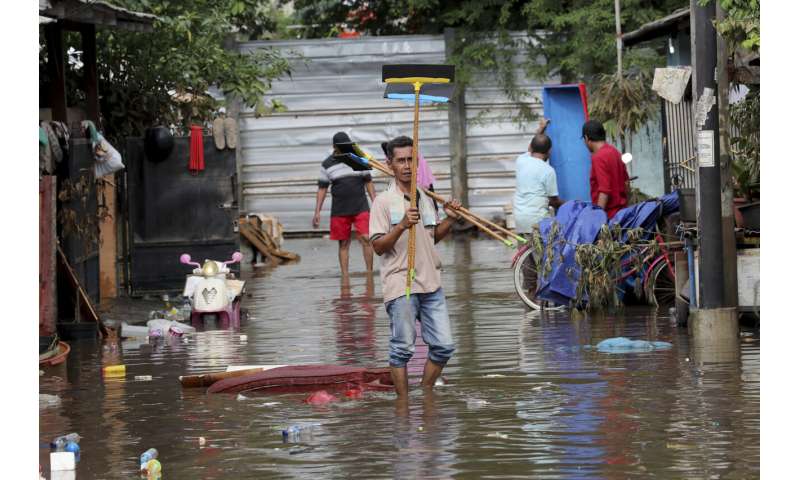
Men prepare to clean their flooded neighborhood in Tanggerang outside Jakarta, Indonesia, Friday, Jan. 3, 2020. Severe flooding in greater Jakarta has killed scores of people and displaced tens of thousands others, the country's disaster management agency said. (AP Photo/Tatan Syuflana)
At the peak of the flooding, about 397,000 people sought refuge in shelters across the greater metropolitan area as floodwaters reached up to 6 meters (19 feet) in some places, Wibowo said. Data released by his agency showed some 173,000 people were still unable to return home, mostly in the hardest-hit area of Bekasi.
More than 152,000 people remain crammed at 98 emergency shelters with sufficient supplies in Jakarta's satellite city of Bekasi, where rivers burst their banks. Much of the city was still submerged in muddy waters up to 2 meters (6.5 feet) high, according to the agency.
Those returning to their homes found streets covered in mud and debris. Cars that had been parked in driveways were swept away, landing upside down in parks or piled up in narrow alleys. Sidewalks were strewn with sandals, pots and pans and old photographs. Authorities took advantage of the receding waters to clear away mud and remove piles of wet garbage from the streets.
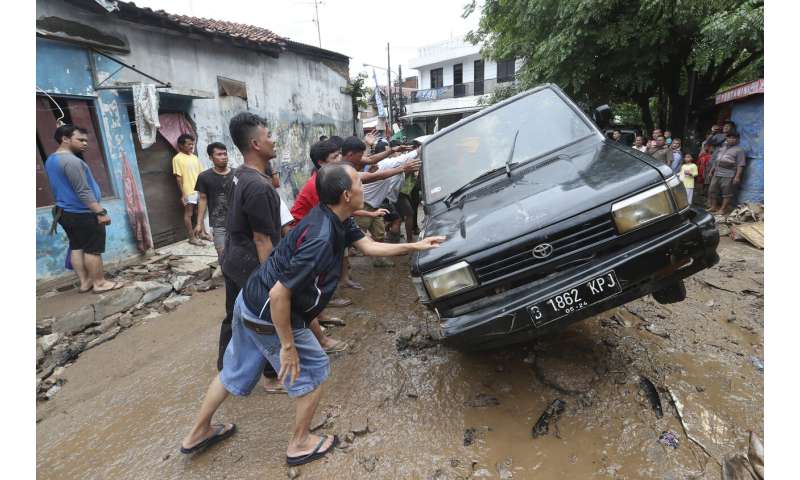
Residents move the wreckage of cars that were swept away by flood in Bekasi, West Java, Indonesia, Friday, Jan. 3, 2020.Severe flooding in greater Jakarta has killed scores of people and displaced tens of thousands others, the country's disaster management agency said. (AP Photo/Achmad Ibrahim)
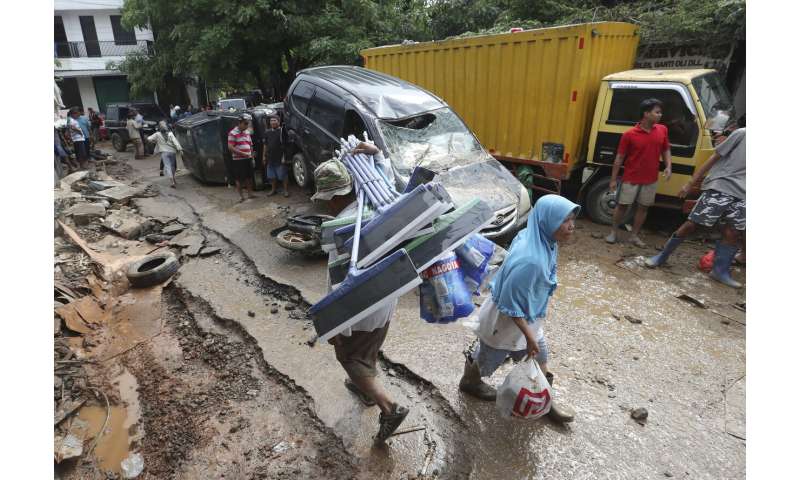
Residents walk near the wreckage of cars that were swept away by flood in Bekasi, West Java, Indonesia, Friday, Jan. 3, 2020.Severe flooding in greater Jakarta has killed scores of people and displaced tens of thousands others, the country's disaster management agency said. (AP Photo/Achmad Ibrahim)
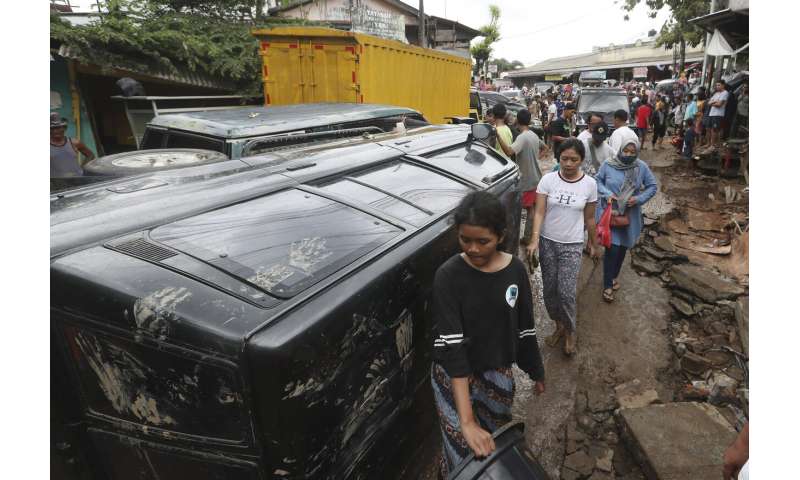
Residents walk near the wreckage of cars that were swept away by flood in Bekasi, West Java, Indonesia, Friday, Jan. 3, 2020.Severe flooding in greater Jakarta has killed scores of people and displaced tens of thousands others, the country's disaster management agency said. (AP Photo/Achmad Ibrahim)
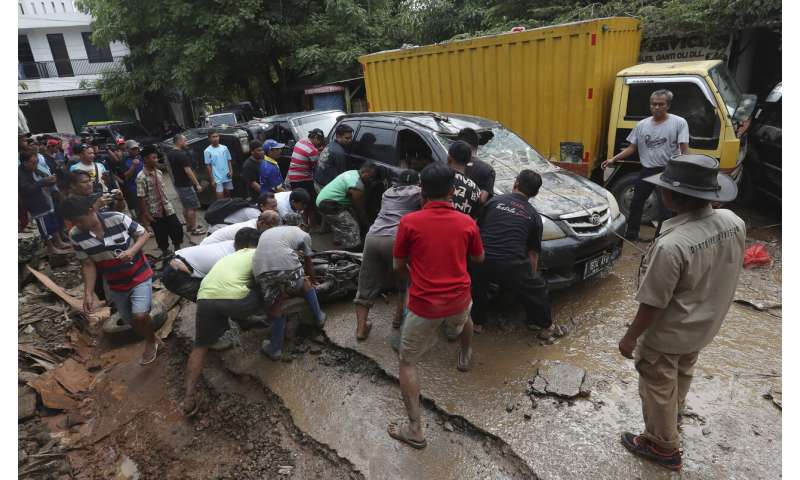
Residents try to move the wreckage of cars that were swept away by flood in Bekasi, West Java, Indonesia, Friday, Jan. 3, 2020.Severe flooding in greater Jakarta has killed scores of people and displaced tens of thousands others, the country's disaster management agency said. (AP Photo/Achmad Ibrahim)

Residents walk near the wreckage of cars that were swept away by flood in Bekasi, West Java, Indonesia, Friday, Jan. 3, 2020.Severe flooding in greater Jakarta has killed scores of people and displaced tens of thousands others, the country's disaster management agency said. (AP Photo/Achmad Ibrahim)

Residents move the wreckage of cars that were swept away by flood in Bekasi, West Java, Indonesia, Friday, Jan. 3, 2020. Severe flooding in greater Jakarta has killed scores of people and displaced tens of thousands others, the country's disaster management agency said. (AP Photo/Achmad Ibrahim)

Residents stand near the wreckage of cars that were swept away by flood in Bekasi, West Java, Indonesia, Friday, Jan. 3, 2020. Severe flooding in greater Jakarta has killed scores of people and displaced tens of thousands others, the country's disaster management agency said. (AP Photo/Achmad Ibrahim)
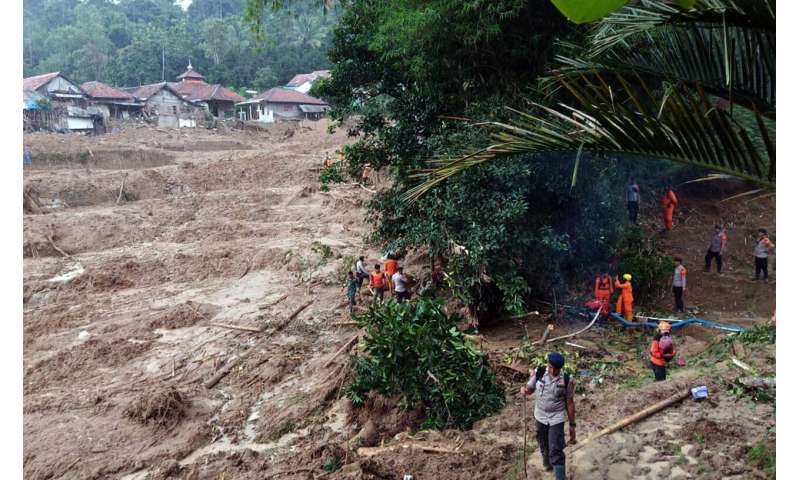
Rescuers search for victims at a village heavily affected by a landslide in Cigudeg, West Java, Indonesia, Friday, Jan. 3, 2020. Monsoon rains and rising rivers submerged hundreds of neighborhoods in greater Jakarta and caused landslides in the neighboring districts, which buried a number of people. (AP Photo/Kozer)

A women stands near the wreckage of cars that were swept away by flood in Bekasi, West Java, Indonesia, Friday, Jan. 3, 2020. Severe flooding in greater Jakarta has killed scores of people and displaced tens of thousands others, the country's disaster management agency said. (AP Photo/Achmad Ibrahim)

Residents walk near the wreckage of cars that were swept away by flood in Bekasi, West Java, Indonesia, Friday, Jan. 3, 2020. Severe flooding in greater Jakarta has killed scores of people and displaced tens of thousands others, the country's disaster management agency said. (AP Photo/Achmad Ibrahim)
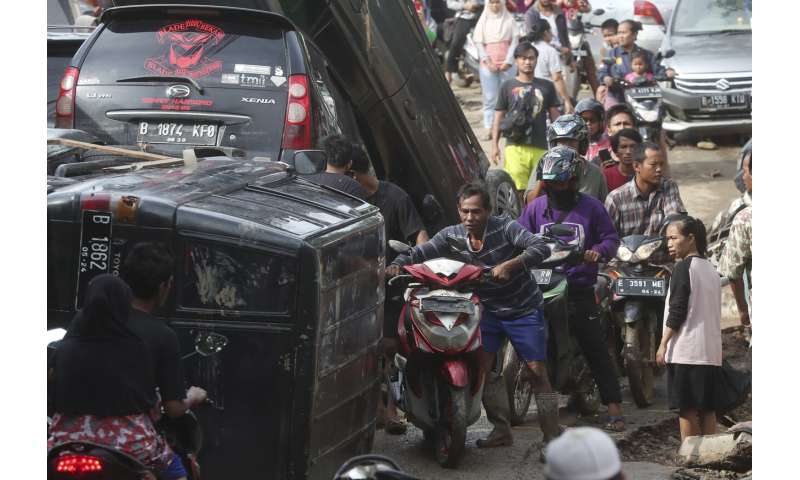
Residents walk near the wreckage of cars that were swept away by flood in Bekasi, West Java, Indonesia, Friday, Jan. 3, 2020. Severe flooding in greater Jakarta has killed scores of people and displaced tens of thousands others, the country's disaster management agency said. (AP Photo/Achmad Ibrahim)
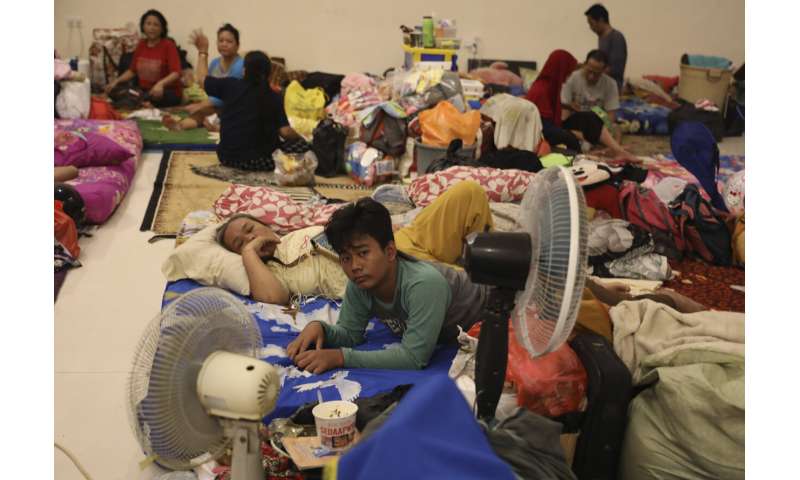
People rest at a temporary shelter for those affected by the floods in Jakarta, Indonesia, Friday, Jan. 3, 2020. Severe flooding in the capital as residents celebrated the new year has killed dozens of people and displaced hundreds of thousands others. (AP Photo/Dita Alangkara)

A woman holds a balloon at a temporary shelter for those affected by the flood in Jakarta, Indonesia, Friday, Jan. 3, 2020. Severe flooding in the capital as residents celebrated the new year has killed dozens of people and displaced hundreds of thousands others. (AP Photo/Dita Alangkara)
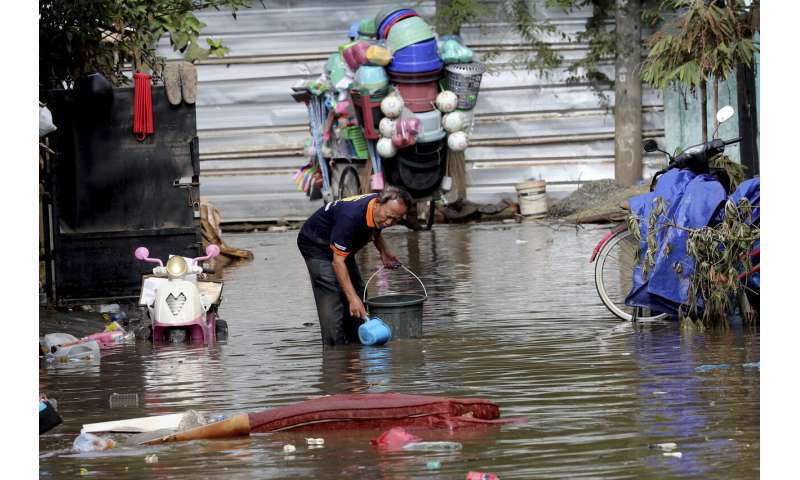
A man collects a water to clean his flooded house in Tanggerang on the outskirts of Jakarta, Indonesia, Friday, Jan. 3, 2020. Severe flooding in greater Jakarta has killed scores of people and displaced tens of thousands others, the country's disaster management agency said. (AP Photo/Tatan Syuflana)
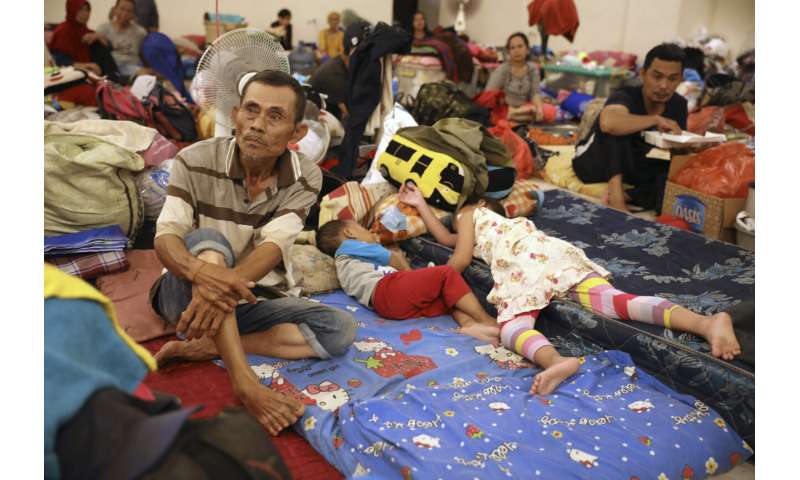
People rest at a temporary shelter for those affected by the floods in Jakarta, Indonesia, Friday, Jan. 3, 2020. Severe flooding in the capital as residents celebrated the new year has killed dozens of people and displaced hundreds of thousands others. (AP Photo/Dita Alangkara)
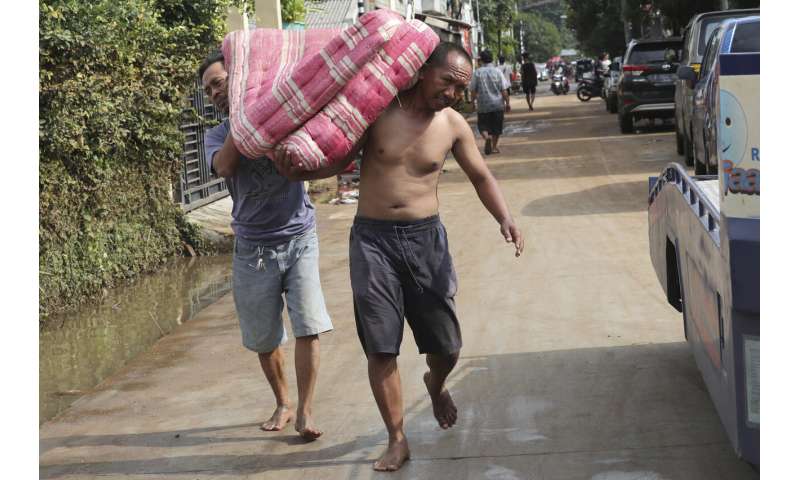
Residents carry a mattresses from their flooded homes in Tanggerang on the outskirts of Jakarta, Indonesia, Friday, Jan. 3, 2020. Severe flooding in greater Jakarta has killed scores of people and displaced tens of thousands others, the country's disaster management agency said. (AP Photo/Tatan Syuflana)
Electricity was restored to tens of thousands of residences and businesses.
Jakarta's Halim Perdanakusuma domestic airport reopened Thursday after its runway was submerged.
The head of the Meteorology, Climatology and Geophysics Agency Dwikorita Karnawati said more downpours were forecast for the capital in coming days and the potential for extreme rainfall will continue until next month across Indonesia.
The government on Friday kicked off cloud seeding in an attempt to divert rain clouds from reaching greater Jakarta. Authorities warned that more flooding was possible until the rainy season ends in April.
The flooding has highlighted Indonesia's infrastructure problems.
Jakarta is home to 10 million people, or 30 million including those in its greater metropolitan area. It is prone to earthquakes and flooding and is rapidly sinking due to uncontrolled extraction of ground water. Congestion is also estimated to cost the economy $6.5 billion a year.
President Joko Widodo announced in August that the capital will move to a site in sparsely populated East Kalimantan province on Borneo island, known for rainforests and orangutans.
© 2020 The Associated Press. All rights reserved.
Citation:
Indonesian capital reels from floods that leave 47 dead (2020, January 4)
retrieved 4 January 2020
from https://phys.org/news/2020-01-indonesian-capital-reels-dead.html
This document is subject to copyright. Apart from any fair dealing for the purpose of private study or research, no
part may be reproduced without the written permission. The content is provided for information purposes only.
#Environment | https://sciencespies.com/environment/indonesian-capital-reels-from-floods-that-leave-47-dead/
No comments:
Post a Comment